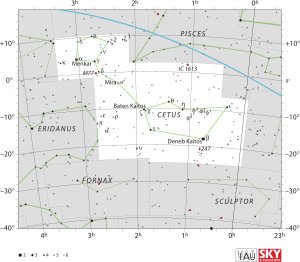Draft:HD 9289
| This is a draft article. It is a work in progress open to editing by anyone. Please ensure core content policies are met before publishing it as a live Wikipedia article. Find sources: Google (books · news · scholar · free images · WP refs) · FENS · JSTOR · TWL Last edited by AluminiumWithAnI (talk | contribs) 0 seconds ago. (Update)
Finished drafting? or |
| Observation data Epoch J2000.0[1] Equinox J2000.0[1] | |
|---|---|
| Constellation | Cetus |
| Right ascension | 01h 31m 16.47427s |
| Declination | −11° 07′ 07.9356″ |
| Apparent magnitude (V) | 9.38[2] (combined) |
| Characteristics | |
| Evolutionary stage | Main-sequence star |
| Spectral type | A3V,[3] A3 SrEuCr[4] |
| Apparent magnitude (K) | 9.08 ± 0.03 (A), 10.77 ± 0.05 (B)[5] |
| B−V color index | 0.25[2] |
| J−H color index | 0.086[6] |
| J−K color index | 0.095[6] |
| Variable type | Rapidly oscillating Ap star |
| Astrometry | |
| Radial velocity (Rv) | 11.352±0.0017[7] km/s |
| Proper motion (μ) | RA: -8.756[1] mas/yr Dec.: −24.435[1] mas/yr |
| Parallax (π) | 3.2569 ± 0.1379 mas[1] |
| Distance | 1,000 ± 40 ly (310 ± 10 pc) |
| Orbit[5] | |
| Primary | HD 9289 A |
| Companion | HD 9289 B |
| Semi-major axis (a) | 0.441±0.003″ |
| Details | |
| Luminosity | 8.7+1.5 −1.3[3] L☉ |
| Surface gravity (log g) | 4.50±0.20[3] cgs |
| Temperature | 8710+410 −392,[3] 7750[8] K |
| Rotation | 8.660±0.006 d[8] |
| Rotational velocity (v sin i) | 10.50[9] km/s |
| Other designations | |
| Database references | |
| SIMBAD | data |
HD 9289 is a white-hued variable star in the constellation of Cetus. It has the variable-star designation BW Ceti (abbreviated to BW Cet). With an apparent magnitude of 9.38, it is too faint to be observed by the naked eye from Earth. It is located at a distance of approximately 1,000 light-years (310 parsecs) according to Gaia EDR3 parallax measurements, and is moving away from the Solar System at a heliocentric radial velocity of 11.352 km/s.
Stellar properties
[edit]The star was first classified as a rapidly oscillating Ap star (roAp) in 1993 when it was found to pulsate at multiple periods, all clustered around 10.5 minutes.[10] Additional observations confirmed the presence of rotational amplitude modulation, similar to the well-studied roAp star HR 1217.[11]
Binary companion
[edit]In 2012, a previously undetected visual companion was discovered at a separation of 0.441 arcseconds to the east-northeast of HD 9289. The probability that the two stars are unrelated and aligned by chance is very low (2.16×10−4 %), therefore the pair are most certainly part of a wide binary system. The secondary star is about 1.70 magnitudes fainter than the primary when observed in the K-band.[5]
References
[edit]- ^ a b c d Brown, A. G. A.; et al. (Gaia collaboration) (2021). "Gaia Early Data Release 3: Summary of the contents and survey properties". Astronomy & Astrophysics. 649: A1. arXiv:2012.01533. Bibcode:2021A&A...649A...1G. doi:10.1051/0004-6361/202039657. S2CID 227254300. (Erratum: doi:10.1051/0004-6361/202039657e). Gaia EDR3 record for this source at VizieR.
- ^ a b Høg, E.; et al. (February 2000). "The Tycho-2 Catalogue of the 2.5 Million Brightest Stars". Astronomy and Astrophysics. 355 (1): L27–L30. Bibcode:2000A&A...355L..27H.
- ^ a b c d Shen, Dong-Xiang; et al. (1 October 2023). "Variability of Magnetic Hot Stars from the TESS Observations". The Astrophysical Journal. 955 (2): 123. doi:10.3847/1538-4357/acf197. ISSN 0004-637X.
- ^ Renson, P.; Manfroid, J. (2009). "Catalogue of Ap, HgMn and Am stars". Astronomy & Astrophysics. 498 (3): 961–966. doi:10.1051/0004-6361/200810788. ISSN 0004-6361.
- ^ a b c Schöller, M.; Correia, S.; Hubrig, S.; Kurtz, D. W. (2012). "Multiplicity of rapidly oscillating Ap stars". Astronomy & Astrophysics. 545: A38. doi:10.1051/0004-6361/201118538. ISSN 0004-6361.
- ^ a b c "HD 9289". SIMBAD. Centre de données astronomiques de Strasbourg. Retrieved 14 November 2024.
- ^ Soubiran, C.; et al. (2018). "Gaia Data Release 2: The catalogue of radial velocity standard stars". Astronomy & Astrophysics. 616: A7. doi:10.1051/0004-6361/201832795. ISSN 0004-6361.
- ^ a b Holdsworth, D L; et al. (13 July 2021). "TESS cycle 1 observations of roAp stars with 2-min cadence data". Monthly Notices of the Royal Astronomical Society. 506 (1): 1073–1110. doi:10.1093/mnras/stab1578. ISSN 0035-8711.
- ^ Joshi, S.; Martinez, P.; Chowdhury, S.; Chakradhari, N. K.; Joshi, Y. C.; van Heerden, P.; Medupe, T.; Kumar, Y. B.; Kuhn, R. B. (2016). "The Nainital-Cape Survey: IV. A search for pulsational variability in 108 chemically peculiar stars⋆". Astronomy & Astrophysics. 590: A116. doi:10.1051/0004-6361/201527242. ISSN 0004-6361.Record for this source at VizieR.
- ^ Kurtz, D. W.; Martinez, P. (27 December 1993). "Discovery of 10.5-minute Oscillations in the Ap SrEu Star HD 9289". Information Bulletin on Variable Stars (3966). Konkoly Observatory, Budapest: International Astronomical Union. Bibcode:1993IBVS.3966....1K.
- ^ Kurtz, D. W.; Martinez, P.; Tripe, P. (15 November 1994). "HD 9289: a new rapidly oscillating Ap star similar to the well-studied, multiperiodic roAp star HR 1217". Monthly Notices of the Royal Astronomical Society. 271 (2): 421–426. doi:10.1093/mnras/271.2.421. ISSN 0035-8711.
- Gruberbauer, M.; Huber, D.; Kuschnig, R.; Weiss, W. W.; Guenther, D. B.; Matthews, J. M.; Moffat, A. F. J.; Rowe, J. F.; Rucinski, S. M.; Sasselov, D.; Fischer, M. (2011). "MOST observations of the roAp stars HD 9289, HD 99563, and HD 134214". Astronomy & Astrophysics. 530: A135. doi:10.1051/0004-6361/201116736. ISSN 0004-6361.
- van Heerden, P.; Martinez, P.; Kilkenny, D. (21 October 2012). "Determination of the rotation periods for the roAp stars HD 9289 and HD 190290 and non-detection of rotational amplitude modulation in the roAp stars HD 75425 and HD 217522: Rotation periods of selected Ap stars". Monthly Notices of the Royal Astronomical Society. 426 (2): 969–974. doi:10.1111/j.1365-2966.2012.21814.x.

